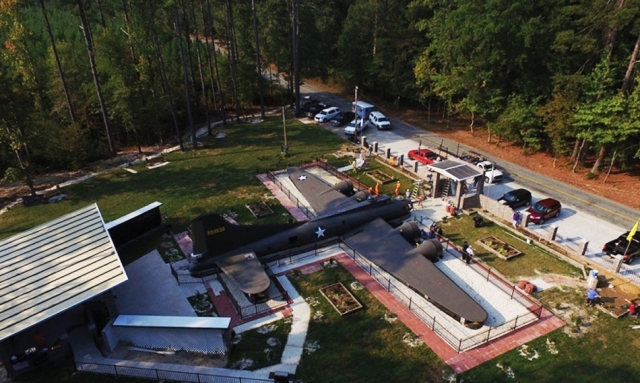
An effort led by American Legion Post 30 in Sheridan, Ark., has created a powerful memorial to nine men killed in a B-17 crash in 1943.
The small city of Sheridan, Ark., represented pain and death to Paula Corrado for most of her life. It was there that a B-17F carrying Corrado’s father and eight other U.S. Army Air Force crew members crashed in March 1943, killing all of them.
But thanks to the work of American Legion Finis Gallion Post 30 and others in the Sheridan community, the crash site now represents much more to Corrado. An effort spearheaded by the post created a memorial to the crew of the Flying Fortress, as well as all Grant County residents killed in action from World War I to the Vietnam War.
"It was a place I never wanted to go (to)," Corrado said of Sheridan, where her father, Tech Sgt. Peter Ivanovich, died on March 12, 1943. "It was a scary place. It was a sad place that I wouldn’t have gone to. I had been a flight attendant and I’d say, ‘I’m not going even to Little Rock.’"
But Corrado’s feelings began to change when she found out about Post 30’s plans – and profoundly changed when she got to the site.
"It was and is a place that gives me serenity. It’s a place that I know is blessed ground. It’s a place I know will never be forgotten. This beautiful memorial is saying, ‘You’ll forever be remembered.’ My Papa Pete used to say to me, ‘Paula, there’s always a rainbow, even in the tear.’ That place has put the rainbow in my tears."
The American Legion B-17 Veterans Memorial Park, located on land owned by Post 30, features a life-size replica of the plane, a 33-foot wide covered black granite wall with photos and information on the plane’s crew, the crash site’s original memorial and a plaque honoring a Boy Scout who had cleaned up the area in 1984, two walls honoring the county’s KIA’s up to the Vietnam War, and two markers honoring Union and Confederate soldiers killed during the Battle of Jenkins Ferry.
Red bricks form a path around the memorial, while flowers and well-manicured grass give the site a feeling of peace and healing. Mounted around the memorial are the U.S. flag, the POW-MIA flag, the Arkansas state flag and the nine flags from the states where each of the men killed in the crash had lived.
The original monument to the men killed was erected in 1944, but the swampy area around it had caused the memorial to be forgotten by most. A local Boy Scout, Jerry Jackson, made it his Eagle Scout project to clean up the area around the memorial in the mid-’80s.
But in 2010, two World War II veterans – Dr. Curtis Clark and Floyd Aldridge – came upon the original memorial and saw it just sitting in the middle of a swamp at a tilt. "Floyd said, ‘This is not right,’ very vocally and emphatically," Post 30 Commander Gary Kelley said. "That started an idea of doing something else. It kept growing."
Kelley said those two Legionnaires and fellow Legionnaire Fred Puckett were the first to form the vision for revamping the memorial and were responsible for the post purchasing the acre on which the memorial resided.
The post then started applying for state grants to start the funding process, as well as reaching out to local businesses and individuals for assistance. Disabled American Veterans Chapter 56 in Sheridan got involved and raised funds for the project.
Mears was tasked with coming up with a design for the memorial, despite having no architectural background. He credits a higher power for coming up with the design. "I think the Lord supplied the vision and used us," he said.
Much of the materials used to fill the swamp area – 300-something dump truck loads – were donated by Sheridan White Rock and Arkansas Decorative Stone. And Acme Brick donated close to 20,000 bricks for the construction. Another business provided free of charge metal panels for construction of the plane.
Most of the labor was provided by trustees from the Sheridan Detention Center through efforts by Grant County Sheriff Ray Vance. "They were out here from daybreak until dark pretty much seven days a week for about a year and a half," Mears said. "They did all the brick work. They built the plane."
The grants totaled about $47,000, with another $50,000 raised. "That’s what built this park – that and the free labor." The memorial was dedicated in 2015, with a ceremony that included relatives of the crew.
"I remember seeing a couple of grown men crying when we put the flags up," Mears said. "What really impacts you is when you see cars pull in here with old World War II guys and Korean and Vietnam (veterans), and they get out of their car and they start crying. They do that because they realize that they’re not forgotten."
The plane, which had taken off from Salinas, Kan., en route to West Palm Beach, Fla., included Ivanovich, 2nd Lt. George H. Davis, 2nd Lt. Robert V. Turchette, 2nd Lt. Leo E. Dolan, 2nd Lt. Phillip E. Niewolak, Tech. Sgt. Dewitt H. Tyler, Staff Sgt. Arthur N. Potter, Staff Sgt. David G. Secorski and Staff Sgt. Kenneth D. Cain, 22, of Hobbs, New Mexico.
"You say, ‘Please God, let me know it’s worth it … and then let me know that someone’s always going to remember them,’" Corrado said. "That’s what the B-17 Memorial and The American Legion have done.
"In those black granites, you can see the reflection of your face in each of them. It’s a reminder that they did it for us."
- Dispatch

